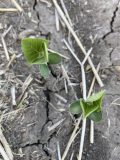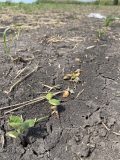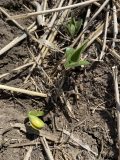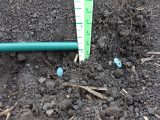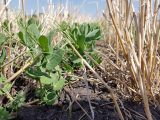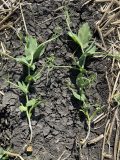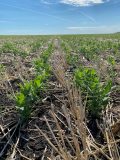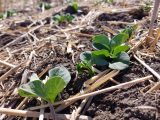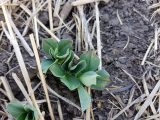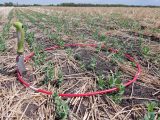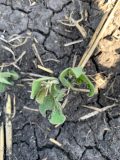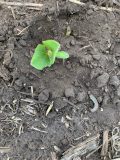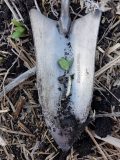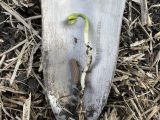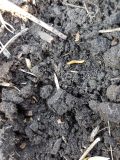JUNE 9, 2021
- Crop Staging and Conditions
- Assessing Pulse and Soybean Plant Stands
- Early Season Insect and Disease Scouting
- Scouting for Cutworms
- Scouting for pea leaf weevil
- Late Soybean Planting
- On-Farm Network Update
Listen to the Bean Report here:
Crop Staging
- Soybeans are mainly at the VE (emergence) to VC (unifoliate) stages, but range from ground crack in the later seeded fields (late May) to V1 (1st trifoliate) in the earlier seeded fields (early May). We’re seeing a lot of uneven plant stands with wide variability in development across the field.
- Dry bean planting wrapped up in western Manitoba over the past week and plants are emerging in central and eastern Manitoba. Under the dry conditions, emergence of some edible bean crops has been delayed by a couple of weeks.
- Field peas are mainly at the V5 to V6 stages (5-6 true nodes), but pea crops range anywhere from V3 to V7 across the province, with nodules forming on the roots. The V6 stage of peas signals the end of post-emergent herbicide application for most products. Late herbicide application can cause yield loss.
- Faba beans are at the V2 to V3 (2nd to 3rd leaf stages), also with nodules forming on the roots. Some faba bean plants had minor frost damage but they’re now growing past it.
Weather and Crop Conditions
- Frost: Many of the earlier seeded soybean fields were touched by frost, with stand loss as severe as 50% or more. But some thanks go to variable emergence, as plants were still emerging after the frost event, which will help top up plant stands. Soybean reseeding decisions were made in a few fields, but most soybean crops can carry on as they are. It also has not made sense in many cases to top up the existing stand due to dry conditions.
- Dry conditions: Crops have appeared wilted and highly stressed under the hot, dry conditions. Recent rainfall has provided some relief, with amounts ranging from 2/10ths to 2 inches, depending on your location. We need the rains to keep coming to alleviate the environmental stress seedlings are experiencing right now. In fields with rolling landscapes, we’re seeing a real difference between hilltops and low spots, with hilltops looking pretty bare at the moment. There have also been a lot of references to the 1980s this spring. So, for some of us, this is a glimpse into the not-so-distant past.
- Heavy winds: Heavy winds have been another stressor for seedlings to deal with this spring. Strong winds in May blew soil and trash around – and it actually increased the seed depth in some areas, and has been causing damage to young seedlings.
- Hail damage: Storms over the weekend brought hail to southern areas of the Red River valley. Assess hail damage and its impact on your soybean crop.
- Hot temperatures: Hot temperatures hinder both crop development and effective herbicide use. Dealing with large weeds in-crop is another problem we are facing this week, although weed emergence has been slow thus far.
For the latest weather details, check out the Manitoba Crop Weather Report.
Plant Stand Assessment
Assessing plant stands each year is an important tool for estimating seed survival to inform future seeding rates. Determine the number of live plants per acre to compare with your seeding rate.
Higher plant populations could mean increased yield potential, but also a greater risk of disease pressure. Lower plant populations mean more attention should be paid towards weed control. If populations are so low you’re considering replanting or topping up soybean stands, read this post to help make soybean replanting decisions.
MPSG’s Bean App plant stand assessor tool is available to calculate plant populations:
- Use the fixed area method to calculate plant populations if using a hoop or a square or the row length method if using a measuring tape or stick.
- Enter your hoop diameter, area of square or length of row measured and the number of plants in that area.
- Assess multiple spots throughout the field and let the tool calculate plants/acre for you.
- Check poor areas as well as good areas and investigate reasons for poor emergence.
- The app feedback is specific to soybeans, but the calculator itself can be useful for other crops.
Early-Season Insect and Disease Scouting
Scouting for early-season insects:
- Cutworms – scout field areas that are slow to emerge or have wilted, yellow or missing plants. Dig around damaged plants to find cutworms. They move deeper in the soil during the heat of the day. It may be easier to spot them under cool conditions or in the evening when they feed.
- Nominal thresholds:
- Soybeans and dry beans: 1 or more cutworms (<2 cm in length) per metre of row, or 20% of plants cut
- Peas and faba beans: 2-3 cutworms (<2 cm long) per square metre
- Nominal thresholds:
- Wireworms – assess crops from planting until V3. Dig into the soil to assess damage to underground parts of young seedlings.
- Seedcorn maggot – an infrequent pest with no established economic thresholds. Cut open suspect seedling stems to find the white to reddish brown larvae.
- Pea leaf weevil – assess field peas and faba beans from emergence to V5 (fifth true node stage) looking for signs of leaf notching. A new pest to Manitoba, confirmed presence in very low populations in northwestern areas (Swan River, Gilbert Plains, Dauphin, Plumas).
Scouting for early-season diseases:
- Root rots in all pulses caused by Fusarium, Rhizoctonia and Pythium – check areas of patchy emergence, yellowing or wilting. Collect a sample to send to the Crop Diagnostic Center for identification.
- Phytophthora sojae in soybeans
- Aphanomyces in peas
Late Soybean Seeding
If you are contemplating late soybean seeding on a few remaining acres, yield potential is lower in June, but good crop yields and maturity before fall frost can be achieved when planting into June.
Research findings from Manitoba:
- Each one-day delay in soybean planting from April 27 to June 16 resulted in an average yield decline of 0.23 bu/ac (Dr. Yvonne Lawley, U of M).
- Soybean yield was reduced by 15%, on average, from late seeding (May 31 to June 4) compared to very early to normal seeding (April 28 to May 24) (Kristen P. MacMillan, U of M).
- In a study examining the potential for extending crop insurance deadlines for soybeans in Manitoba, soybeans maintained 80% yield potential (the benchmark for late seeding deadlines) when seeded as late as June 12 at Morden (MASC risk area 1) and Portage (risk area 2), and as late as June 6 at Arborg (risk area 3) (Kristen P. MacMillan, U of M).
On-Farm Network Update
Moisture Benefits with a Switch in Tillage Type?
For the second year, the OFN is hosting dry bean tillage trials, comparing strip-till and conventional till in pintos and black beans. This season, in addition to investigating yield effects, we’ll be tracking residue decomposition in the untilled strips (between the berms in strip-till plots) and measuring soil moisture over the season in both strip-till and conventional till plots. Check out the OFN Twitter account for soil moisture observations at planting!
investigating yield effects, we’ll be tracking residue decomposition in the untilled strips (between the berms in strip-till plots) and measuring soil moisture over the season in both strip-till and conventional till plots. Check out the OFN Twitter account for soil moisture observations at planting!


